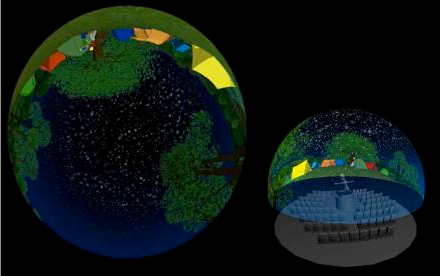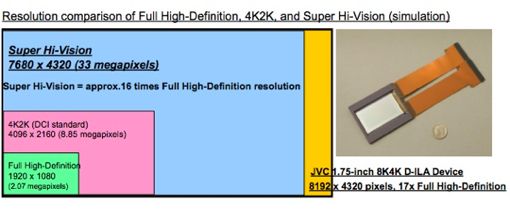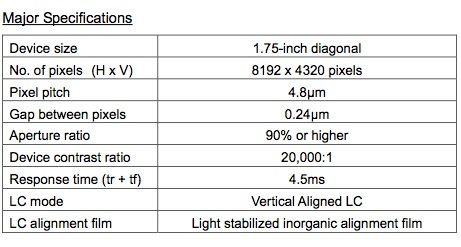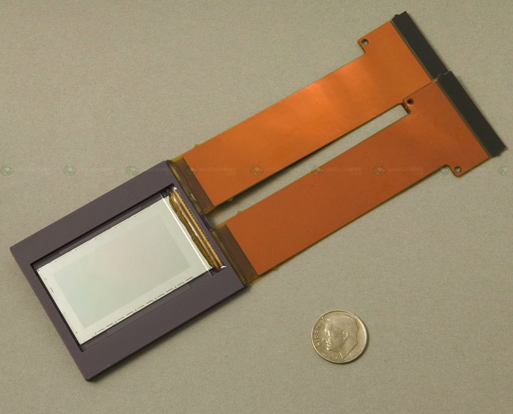3. Fulldome Festival im Zeiss-Planetarium Jena
Die Initiatoren sind sich einig, dass FullDome die Möglichkeiten der räumlichen und filmischen Darstellung erweitert, und dass die Inszenierung von immersiven Erlebnissen in 360° für Medienkünstler ein zukunftsträchtiges Sujet darstellt. Im Mittelpunkt des Festivals stehen künstlerische Experimente und studentische Arbeiten in der 360-Grad-Kuppelprojektion. Aber auch professionelle Anwendungen für Planetarien und aus Bereichen wie Unterhaltung, Kunst, Wissenschaft, interaktive Welten und Musik beleuchten die Perspektiven, die sich der weltweit wachsenden Fulldome-Community und dem interessierten Publikum eröffnen. Die Ergebnisse und Preisträger werden beim 3. FullDome-Festival im Zeiss-Planetarium Jena am 24./25. April 2009 zusammen mit dem Sonderprogramm „Bauhaus in den Sternen“ präsentiert.

Festival Programm
Die FullDome Präsentationen und Festivalbeiträge erfolgen an zwei Tagen: zum studentischen Festival am 24. April und zum Festival-Summit am 25. April, mit den besten studentischen und allen anderen Arbeiten. Der genaue Programmablauf - auch zum Spezialthema „Bauhaus in den Sternen” wird an dieser Stelle veröffentlicht und beim Veranstalter www.planetarium-jena.de Bereits am 23. April findet im Zeiss-Planetarium Jena ein Vortrag des Trend- und Zukunftsforschers Matthias Horx zum Thema „Bauhaus revisited” statt, ebenfalls ein Beitrag zum Jubiläumsjahr „Bauhaus 2009″. Mehr zum Thema: www.horx.com und www.zukunftsinstitut.de
Allgemeine Teilnahmebedingungen
Einsendeschluss der Festivalbeiträge ist der 15. April. Alle eingesandten Festivalbeiträge werden nach einer Vorauswahl durch die Jury ausschließlich im Rahmen des 3. FullDome-Festivals im Zeiss-Planetarium Jena aufgeführt. Die Jury wählt unter den aufgeführten Beiträgen die Preisträger aus. Alle Einsendungen werden nach den gleichen Auswahlkriterien bewertet: Inhalt und Gestaltung, technische Umsetzung, künstlerische Ausführung, Kreativität, Originalität, narrative Qualität, Unterhaltungswert, sowie allgemein der Beitrag zur künstlerischen, innovativen und technischen Entwicklung des FullDome-Mediums.
Weiterführende Links
FullDomeFestival 2009
Bauhaus-Universität Weimar
liquidsound
Zeiss-Planetarium Jena
Immersive Film Festival, Espinho, Portugal

Navegar Foundation would like to invite all to participate and attend the Immersive Film Festival, to be held at Centro Multimeios Espinho, Portugal, on April 24th-26th 2009.
This festival is an event that will gather international productions in the Immersive Cinema field. It is an open invitation to all, including producers, animators, filmmakers, artists, students, teachers and planetarium professionals, in order to participate in this unique event.To participate, simply submit a work following the guidelines of the memorandum of understanding (MOU).
IFF will be focused on presenting productions in this media, along with a competition among submitted productions that made its debut recently. Besides the competition and the public screenings, public talks will be held to promote immersive cinema. Special screenings for primary and secondary schools will also be organized.
It is intended to be a space to captivate active members of cinema in general into this new media, a space to discuss ideas and to create partnerships, and above all, to work as a catalyser to the development of this area of cinema.
Immerse Yourself! Hope to see you at IFF 09.

Planetarium Tech - Beyond the Infinite
Super High Vision Single Display from JVC
If we have yet to see this resolution on upcoming video projectors, I'll bet such a resolution will soon be a reality... We just hope that something like the Red Video camera will also soon be accessible to us all!


Victor Company of Japan, Ltd. (JVC) announces a new addition to its lineup of proprietary D-ILA (Direct-Drive Image Light Amplifier) high-definition reflective liquid crystal devices for projectors. The newly developed 1.75-inch 8K4K D-ILA device has the world's largest number of pixels and is able to display images of approximately 35 megapixels (8192 x 4320 pixels), the equivalent of more than 17 times the level of Full High-Definition. This means that a single display device can now produce Super Hi-Vision images and can display images with the highest number of pixels currently defined under international standards.
After JVC developed the initial 7.86-megapixel (3840 x 2048 pixels) 4K2K D-ILA device in the summer of 2003, it subsequently further evolved the technology for highly realistic, high-definition images through a range of test viewings and verification testing, resulting in the development of JVC’s first commercial 4K2K D-ILA device (1.7-inch device size, 5,000:1 device contrast ratio) and the 4K2K D-ILA projector incorporating that device in September 2004.
In June 2007 JVC developed a 1.27-inch 4K2K D-ILA device that was the world's smallest device of its kind, having a 6.8µm pixel pitch and 4096 x 2400 pixels, and in February 2008 it began marketing a newly commercialized professional D-ILA projector, DLA-SH4K, incorporating that device.
Through the development of a new production process and new pixel structure for even finer pixels, JVC has now succeeded in developing the 1.75-inch 8K4K D-ILA device, the world's first device to achieve real Super Hi-Vision definition level. The new device has approximately 50% higher density in its ratio of area per pixel as compared to the 1.27-inch 4K2K D-ILA device, which was originally the world's smallest 4K device. Furthermore, the new device has achieved a video display of approximately 35 megapixels, the world's highest pixel counts, while continuing to provide the D-ILA series' characteristics such as “high-quality images without a distracting pixel structure”, “high light availability”, and “high contrast ratio”.
NASA sees potential in Immersive Visualisation
Absorbing the Big Picture: Immersion and Interactivity in Science Education
Rapid advancements in communication technologies are enabling unprecedented opportunities for science outreach and education. High-speed networks, video game engines, scientific visualization toolkits, geospatial viewers, innovative input devices, and immersive digital displays are increasingly at the disposal of both formal and informal education specialists. However, new technologies too often provide little more than temporary novelty if they're not thoughtfully integrated with other pedagogical elements to create meaningful and compelling experiences.
In this lecture/presentation, David McConville will illustrate the ways in which new interactive technologies and spatially immersive displays can be utilized to more fully engage students and the public in the science education process. Applying findings from cognitive psychology, gaming theory, and experiential education research, he will demonstrate how new collaborative and socially-oriented visualization tools have the potential to enable more intuitive and self-directed learning for students, scientists, policy makers, and the public.
About The Speaker
David McConville is a media artist and researcher focused on the development of the most compelling uses of immersive virtual environment displays. He is the co-founder and Director of Noospheric Research of The Elumenati, a full service design and engineering firm specializing in the development and deployment of immersive visualization experiences. The Elumenati provides systems integration, real-time software design, immersive content research, custom fabrication, and optical engineering for broad range of clientele. David holds a BSc in Music and Audio Engineering from the University of North Carolina Asheville, and he is currently a PhD candidate through the Planetary Collegium at the University of Plymouth.
Off Site Access Watch this presenation here. NOTE: You will need to have Microsoft MediaPlayer installed to view this presentation.
Download the presentation as a PDF for free:
"Absorbing the Big Picture: Immersion and Interactivity in Science Education" (44.6 MB)
2. Workshop in Immersive Cinema
International speakers this year will be Dr. Carter Emmart (American Museum of National History), Dr. Gill Russel (CosmicSky), Benjamin Crabut (RSA Cosmos), Lars Lindberg Christensen (ESA), Luis Calcada (ESO), Michael Daut (Evans & Sutherland), David McConville (Elumenati Inc.), Tom Kwasnitschka (AllSky.de), Staffan Klashed (SCISS) and Martin Howe (SEOS).
More information at http://fulldome.multimeios.pt
Cinema has always been a unique way to present audiences with memorable and unparalleled experiences. Its popularity is unquestionable and it seems to be, among all the art forms, the most consensual and the one able to captivate a public of all tastes, ages and backgrounds The advance in technology has naturally pushed cinema to the digital era. The quality of the images and the tools available to capture and project them are increasing. Going to the movies is more and more a unique experience, the images are becoming more and more clear and realistic, and the digital effects give the spectator strong sensations and create in the audiences the desire for other kind of film formats.

Digital cinema opened new horizons in film production: new techniques, new audiences, new languages make films more and more all embracing, easier to produce and more accessible. One of the areas that will necessarily benefit from this revolution is education, cultural diffusion and entertainment. As an example we can point the use of immersive cinema in cultural centres, museums, theme parks and other education and entertainment equipments, working as a new means of promoting and transmitting knowledge. Its versatility and the almost infinite range of possibilities of use, as well as the relative easiness in producing contents when compared with more traditional formats, makes immersive cinema very attractive. Its production is growing and it promises to change the way of making movies
Workshop: Immersive Cinema
International speakers will be Ed Lantz (Visual Bandwidth), Harald Singer (LivinGlobe), Benjamin Crabut (RSA Cosmos), Robin Sip (MirageIIID), Tim Horn (Planetarium Hamburg), Michael Daut (Evans & Sutherland), David McConville (Elumenati Inc.), Johan Gijsenbergs (Sky-Skan Inc., Europe), Staffan Klashed (SCISS) and Ian Dyer (SEOS).
More information at http://fulldome.multimeios.pt
New computer animation available
The new video clip is available for museums and planetariums under public common licence fee and for TV broadcasts. Please contact our sales department.
